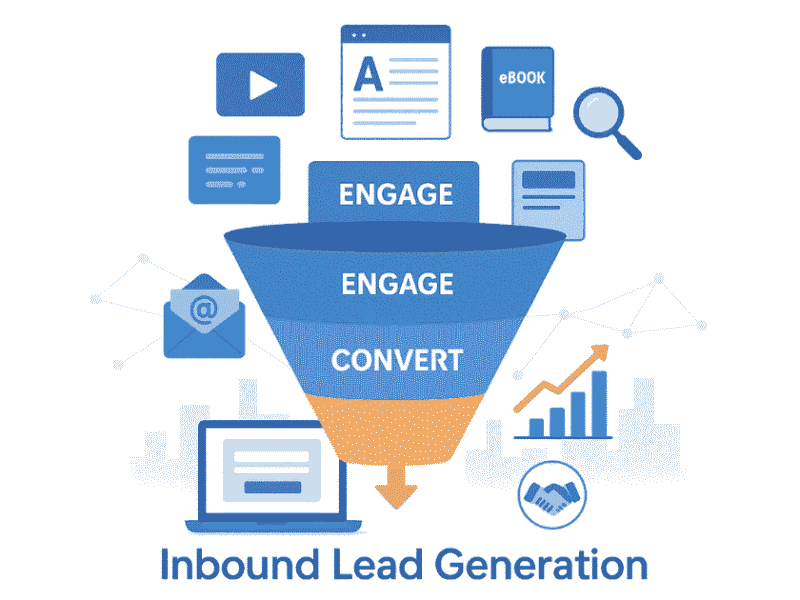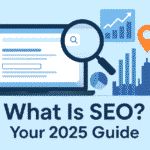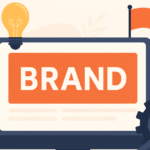Inbound lead generation is concerned with your pulling prospects into your business but not forcing your offerings on them. It is about providing useful content and experiences that appeal to your target customer making them feel willing to connect to your brand.
Inbound lead generation is at its simplest, an idea of attracting and not interrupting. The inbound methods, unlike the old outbound methods, are based on relationship-building, rather than on aggressive sales techniques. This has the benefit of creating trust and establishing your brand as a thought leader and a dependable source.
The difference between inbound and outbound lead generation is in the way and the tools. Certain inbound strategies use content marketing, SEO, and social media to attract prospects to the company, and outbound strategies may involve cold calling and direct mail. Learning such disparities will allow you to make your marketing endeavors more relevant in the digital age.
A pull strategy is where content is produced to just appeal to your target audience. This involves knowing their needs, problems and interests in order to create content that is not only informative but also interesting. That way, you are not only getting leads but also carrying them along the buyer path.
Table of Contents
The Importance of Inbound Lead generated
The significance of inbound lead generation is that it enables business to create trust to the potential customers. You will also place your business as a helpful tool to the prospects, by providing useful information and solutions, thus they will be more inclined to purchase your products or services when they are willing to do so.
Establishing Long-lasting Relationships.
The generation of inbound leads does not merely mean generating leads, but creating relationships that are long-term. Through continuous value delivery you keep your brand on the frontburner and when the time to make a purchase comes, they will remember you first. This is the relationship-building factor that is important in creating customer loyalty and advocacy.
Enhancing Brand Authority
By providing professional information and knowledge, you build authority in your brand within your area of industry. This not only generates more leads, but it also generates better quality leads. The more authority you have the more you are likely to attract your audience to your content and authority.
Inbound Strategy Cost-Effectiveness.
Inbound lead generation may prove to be less expensive than the traditional outbound. Although the initial investment in creating content and technology may be high, based on the level of returns, it can be high. Through organically sourcing high-quality leads, you save the cost of an advertising campaign, which is pretty costly, thus increasing your marketing budget.
Best Lead Generation Strategies in Inbound.
In order to create inbound leads successfully, you should use a number of different strategies that address the interests and needs of your audience. These are some of the established methods:
Content Marketing
Inbound lead generation is based on content marketing. You can attract and engage your target audience by developing and sharing useful content. This content may be in various formats, such as blog posts, e-books, videos and webinars.
Types of Content to Consider
Variety in content that you create can also be used to target various subgroups of your audience. Blogs posts will give in-depth information, e-books will have a comprehensive guide, and videos will simplify complex issues. Webinars, by contrast, are real-time and interactive, which means that you can interact with the audience and answer their questions and concerns in real-time.
Creating a Content Strategy.
To be able to direct your content marketing, a carefully planned content strategy is needed. The first step is to find out the needs and preferences of your target audience. Next, plan a content agenda that has these facts in mind so that there is steady stream of content that is interesting and meaningful. Such strategy will keep the viewers engaged and increase leads.
Measuring Content Success
Measures of effectiveness of your content marketing include monitoring your traffic to the site, social media shares and conversion rates of leads. Such tools as Google Analytics may give a precise analysis regarding the performance of your content, and you can make evidence-based changes to your strategy.
Search Engine Optimization (SEO)
SEO is necessary to make search engines find your content. With the help of the relevant keywords made out of your webpage and content, you are able to be more visible and to draw more organic traffic.
The Role of Technical SEO
Technical SEO is a way of improving the search engine performance of the website by optimizing the back-end of your site. This involves making sure that your site is mobile-friendly, loaded quickly, and encrypted via secure HTTPS. These are technical factors that help in improving user experience which the search engines compensate by ranking the pages highly.
Local SEO for Targeted Reach
Local SEO plays a significant role in the business that aims at a narrow geographical region. Local customers can more easily be reached by optimizing your site with local search terms and keeping up with the current Google My Business listing. This local strategy would go a long way in supplementing your inbound lead activity in your community.
Ongoing SEO Audit and Optimization.
SEO is not a process that is completed in one time. It is also possible to regularly perform SEO audit to find out what can be improved and make sure that your site is search engine optimized. You can keep your search positions and further enhance them with the help of the current trends in SEO and the modifications in the algorithm.
Social Media Marketing
The social media platforms are potent inbound lead generation tools. Sharing your content, communicating with your audience on social media will allow you to raise brand awareness and traffic to your site.
The development of a Social Media Strategy
The first step to an effective social media strategy is to know which social media platforms your target audience visits. Adapt and shape your content to different platforms and cultures. Using specific goals, like reaching more people or getting traffic to your site, you can develop specific campaigns that can appeal to your audience.
The use of Social Media Analytics.
Social media analytics gives you useful information on performance of your content in various platforms. Monitoring the levels of engagement, shares, and increasing the number of followers, you can determine which content appeals to your audience and optimize your strategy to achieve improved outcomes.
Building a Community
Creating a community with your brand on social media is not as simple as posting content. It involves active interaction with your audience in the form of comments, messages and discussions. The feeling of community that you promote not only makes your brand more loyal, but also makes your audience become brand ambassadors.
Email Marketing
Email marketing is one of the best methods of operating leads and steering them through the sales funnel. With targeted and personalized content, you are able to keep your audience interested and motivate them to act.
Segmentation for Personalization
It is possible to communicate more personally by dividing your email list. When you combine subscribers who share demographics, behavior, or interests, you are able to customize your messaging to the level that is most useful to them. This attention to a specific person becomes more involved and enhances conversion.
Composing Irresistible Headlines.
What your subscribers see first is the subject line which is therefore very important in catching their attention. Writing powerful and meaningful subject lines would help a great deal to boost your open rates. Experiment with various strategies and A/B test to find out what works best with your audience.
Automating Your Email Message.
The automation of email can enhance your marketing campaign by automatically sending emails at time-delays, like when someone signs-up or leaves a cart. This will guarantee you timely communication and more personalized experience to your subscribers, which will improve your lead nurturing process.
Leveraging Technology for Inbound Lead Generation
Technology plays a vital role in streamlining and enhancing your inbound lead generation efforts. The following are some of such tools and platforms:
Marketing Automation
Marketing automation platforms, like HubSpot or Marketo, can help you manage and automate your inbound lead generation activities. They enable you to monitor and understand lead behavior, split your audience and provide personalized content at scale.
The Right Automation Tool.
The appropriate marketing automation tool is an important choice to your lead generation success. Ease of use, integration and customer support are just a few factors that should be considered when considering options. The tool used must be suitable to your business objectives and be able to scale as you grow.
Automating Customer Journey.
Marketing automation enables you to automate different steps of the customer experience process, including the capture of leads and their conversion. With automated workflows established, timely and relevant communication is guaranteed, which leads to the better customer experience and the chance of conversion.
Integrating Automation with CRM Systems
By combining your marketing automation system with your CRM system, you can get a comprehensive picture of your leads and customers. Better data sharing and analysis is made possible through this integration, so that you can more effectively tailor your marketing efforts and enhance lead nurturing.
Customer Relationship Management (CRM) Systems.
One of the CRM systems that can be useful when it comes to organizing and managing your leads is Salesforce or Zoho CRM. Through monitoring contacts and capturing lead data, you can learn important details about your prospects and their needs and preferences so that you can shape your marketing activities accordingly.
Lead Management CRM Benefits.
CRM systems are made to give you a centralized database of all your lead information and this way it is easy to manage and monitor the interactions. This centralized model enhances better communication in your team, follow-ups are consistent and eventually lead to better lead management and increased conversion rates.
Enhancing CRM to Your Business.
The most significant factor of making the best out of your CRM system is customization. The platform can be configured to align with your business processes and workflows, and it should be configured to support your unique lead generation and nurturing strategies. This personalization improves productivity and will make your CRM investment worthwhile.
Training Your Team on CRM Usage
In order to get the full advantage of your CRM system, you need to consider training your team on how to use it and what best practices are. Constant training would make your team familiar with using the system efficiently so that data management would experience a better outcome, and the lead generation would also be enhanced.
Analytics and Reporting Tools.
Analytics tools, like Google Analytics, can help you measure the success of your inbound lead generation strategies. Keeping a check on key performance indicators (KPIs), e.g. the traffic of the websites, the rate of conversion, and the level of engagement, will help you see what needs changes and work on it to the fullest.
Setting Up Goals and Tracking
When it comes to analytics, it is important to set specific goals and monitor them when it comes to measuring success. Tacking the form submissions or the downloads, you can set these goals and evaluate the effectiveness of your strategies and make correct decisions to improve them.
Analyzing User Behavior
Knowledge of how your site is being used by a user can give you some insight into what is functioning as well as what requires enhancement. After evaluating the metrics, including bouncing rates, length of stay, and user paths, you can determine the places of bottlenecks and restructure your site to provide improved user experiences.
Continuous Improvement using Data.
Data-driven decision-making is essential for continuous improvement in inbound lead generation. Reviewing analytics reports frequently and making adjustments based on the data will make sure that your strategies are effective and that they support your business goals.
Measuring the Success of Your Inbound Lead Generation Efforts
To ensure your inbound lead generation strategies are effective, it’s essential to track and analyze their performance. Some of the key measures to monitor are the following:
Lead Conversion Rate
The Lead conversion rate is a measure of the percentage of visitors who turn into leads on the site. When the conversion rate is high, it means that your audience is responding to your content and calls-to-action.
Elements that have an impact on conversion rates.
Your lead conversion rates can be impacted by several factors such as the design of a site, user experience and the quality of the content. By improving upon these factors, you will be able to produce a more interesting user experience that will drive conversions.
A/B Testing for Optimization
A/B experiment is an effective way of maximizing your conversion rates. Through trial and error or testing various versions of your content, landing pages or calls-to-action, you can discover what appeals most to your audience and refine your strategy accordingly.
Monitoring Conversion Trends
A frequent check of the conversion trends can assist you in determining trends and adjusting proactively your strategies. To gain insight into these trends, you can predict shifts in the behavior of the audience and adjust your marketing to achieve more.
Cost Per Lead
The cost per lead will make you know how effective your lead generation activities are. You can determine the most cost effective strategies by comparisons of the cost of obtaining leads in various channels.
Calculating Cost Per Lead
To find your cost per lead divide the total cost you have spent in leading generation by the number of leads you have. It is a calculation that will give you a clear understanding of how efficient your campaign was and will assist you in spending your marketing budget in a more efficient way.
Cutting Costs through Inbound Strategies.
By bringing in traffic, inbound strategies like content marketing and SEO may allow you to lower your cost per lead. You can attract leads much more cheaply, and reduce the total cost of acquisition by concentrating on high quality, valuable content.
Comparison of Channel Performance.
The ranking of the performance of various marketing channels allows you to find those that provide the best performance at the minimal cost. With such analysis, you can focus your efforts on channels that will be most effective to your purpose and direct your marketing budget.
Engagement Metrics
Track your engagement rates, including time on site, bounce rate, social media interactions, to determine how well your content and marketing is working.
Knowledge of Audience Engagement.
One of the major indicators of the effectiveness of your content to your audience is the level of audience engagement. Measures that can be analyzed like the number of hours spent on site and page views allow you to understand what content is most appealing and change your strategy based on it.
Improving Engagement Through Personalization
Audience can be greatly improved through personalizing it. With personalized content and experiences, you can make the user experience more meaningful and compelling to get them to engage with your brand more intensely.
The use of Feedback to Improve.
Gathering and reviewing feedback of your audience can give you important information about what you can improve. By responding to the concerns and preferences of the audience you can improve your content and marketing strategies, which will eventually result in better engagement and lead generation performance.
Conclusion
Inbound lead generation is a powerful strategy for attracting and converting high-quality leads. With the measures in this paper, you would be able to produce good content and experiences that appeal to your intended audience, generate trust, and ultimately achieve business growth. Always remember to use technology and measure your performance so that you can maximize your work and be successful in the long run.
FAQ’s
What is Inbound Lead Generation and what is the difference between this and outbound?
Inbound Lead Generation means to impress the potential customers with valuable contents, SEO, and social communication so that the prospects might learn about your brand in a natural way. Inbound is also used to establish trust and attract customers with useful materials unlike outbound approaches like cold calls or paid advertising.
How do you qualify leads in Inbound Lead Generation?
Leads are also qualified based on your Ideal Customer Profile (ICP) and through lead scoring. Inbound Lead Generation assigns points depending upon both user activities (e.g. downloading an eBook, attending a webinar) and attributes (e.g. job title, company size). High scoring leads get transferred to sales as Sales Qualified Leads (SQLs).
What tools are most effective for Inbound Lead Generation?
The most important tools are marketing automation software, CRMs, search engine optimization tools, chatbots that are based on AI, analytics dashboard, and interactive content platforms. These applications complement the Inbound Lead Generation, focusing on simplifying the lead capture, nurturing the prospects, and real-time engagement.
What content works best for Inbound Lead Generation?
The types of content that have done well are blog posts, case studies, webinars, explainer videos, eBooks, templates, and interactive files such as quizzes or calculators. Effective Inbound Lead Generation content addresses customer pain points at every stage of the buyer journey–awareness, consideration, and decision.
How has buyer behavior impacted Inbound Lead Generation strategies?
Contemporary consumers enjoy to inform themselves and do research online and not to interact with salespeople. This change elevates the importance of Inbound Lead Generation like never before, of having customized, more reachable and valuable content that appeals to buyer needs, and provides some trust early in the process.
What mistakes should businesses avoid in Inbound Lead Generation?
Common mistakes include:
- Focusing on lead volume, as opposed to lead quality.
- Slow reaction to questions.
- Lack of cohesion among marketing tools and CRM.
- The dependence on one channel such as SEO or ads.
- Making un-personalized generic material.
- Not taking lead nurturing campaigns into account.
Avoiding these traps assists companies to get the best ROI of Inbound Lead Generation and turn more qualified prospects.









